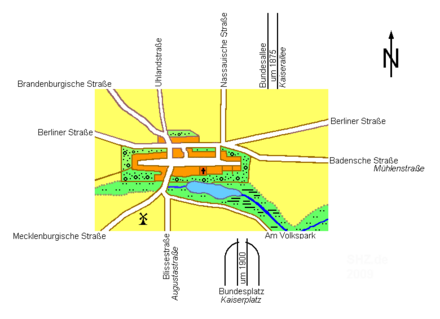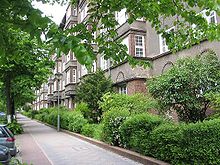Wilmersdorfer See
The former Wilmersdorfer See was in the Berlin district of Wilmersdorf , near the Wilhelmsaue street , the former center of Alt-Wilmersdorf. The lake was filled in from 1915.
With a bathing establishment built by the " millionaire farmer " Otto Schramm , the waters established the reputation of the then independent community as the seaside resort of Wilmersdorf in the 1880s . At that time, the Tanzpalast Schramm am See was one of the most popular entertainment centers for Berlin's urban population and for neighboring places such as Schöneberg , Charlottenburg or Schmargendorf : "Karlineken, wat meenste, morjen jehn wa bei Schramm, een danzen", it was said in Berlin.
Geology and lake
Geologically , the Wilmersdorfer See belonged to a swampy fen with a ditch that connected the last lakes and ponds that had remained after long silting processes from an Ice Age glacial channel ( Grunewald chain of lakes ). Since large parts of Wilmersdorf consisted of swampy terrain , which made it impossible to build on and fortify the roads, and to remove sewage, the area was drained towards the end of the 19th century as part of the Hobrecht Plan by building and developing a sewer system with drainage ditches . This action prepared the integration of Wilmersdorf into the city of Greater Berlin . The expansion of the natural Black Trench , later the Main Trench , played a decisive role . This trench was filled in in 1887. After that the water level sank and the lake dried up increasingly. Around 1920 it was finally filled in.
Today the western part of the park is located in the middle of the Wilmersdorf park with two sports fields and other leisure facilities between the Mecklenburgische Strasse - Uhlandstrasse - Bundesallee . Together with the neighboring Schöneberg Rudolph-Wilde-Park , the Volkspark forms an inner-city green corridor around 2.5 kilometers long and 150 meters wide, the character of which is clearly recognizable as the remaining depression of a former water drainage channel from the thawing glaciers .
The settlers who came to the area in the 13th century to develop the young Margraviate of Brandenburg lived, in addition to farming and later sheep breeding, for a long time from fishing in the Wilmersdorfer See.
history
Millions of farmers
With the economic boom of the Wilhelminian era there was a rapid growth in Berlin's population, which quadrupled from 500,000 to two million between 1861 and 1910. The growth brought enormous urban planning and traffic problems with it. The railroad needed space and wealthy Berliners were increasingly looking for quieter and secluded living areas, which they found in Deutsch-Wilmersdorf or Schöneberg in the 1870s.
Forward- looking construction investors and speculators, as well as the Stadtbahn and Ringbahn , bought large areas of land and literally showered the Wilmersdorf and Schöneberg farmers with money, which is why they went down in history as "millions of farmers ". The writer Max Kretzer set them a literary- dramatic monument in 1891 with the two-part novel The Farmer of the Millions and the eponymous bourgeois-noble tragedy . Max Kretzer had two young aristocrats report in his novel :
“It was a small Brandenburg idyll that the railroad gave more and more of its urban character from day to day. The peaceful calm was only interrupted by the noise of the guests in the upper part of the garden. The stalls of the bathing establishment appeared on the right. When Heckenstett saw her, he immediately asked whether it was the famous Wilmersdorfer Seebad, about which he had already heard so much. He remembered that a little cleaning lady had jokingly told him that she used to travel to the Bad in Wilmersdorf every summer. "
Wilmersdorf seaside resort
One of these "millionaire farmers " was Georg Blisse from Wilmersdorf , another the large farmer Schramm, whose son Otto (1845–1902) recognized very early that Berliners would have a great need for leisure and entertainment opportunities and that Wilmersdorf could be made for this . In 1879 Otto Schramm therefore invested part of the million dollar fortune in the purchase of an area of around 2500 m² on the south bank of the Wilmersdorfer See, on which he had a bathing establishment and a coffee garden built. The baths and restaurants were enthusiastically received by the Berlin population and established the town's reputation as a seaside resort in Wilmersdorf .
Schramm dance palace
The coffee garden quickly developed into a large beer garden with the gigantic Schramm dance palace - “Let's go to Schramm” became a catchphrase of the pleasure-loving Berliners. “Karlineken, wat meenste, morjen jehn wa bei Schramm, een danzen” was the name of the Berlin dialect of the time, writer Hanns Fechner tells us . Many young Berliners have shown themselves to be “electrified” by this offer.
Young officers and impoverished aristocrats in particular resorted to “daring a dance with the village beauties”, not always without ulterior motives:
“On Sundays you saw the village beauties [...] dressed in the heaviest silk fabrics, hung with precious jewelry, spinning in circles at the Schramms [...]. Many a farmer's daughter of millions was recently married away from there. "
Decline of the seaside resort
At the beginning of the 20th century, the seaside resort and dance palace faced considerable competition. In 1904, the terraces on Halensee opened around four kilometers away , and the seaside resort had nothing comparably attractive to match its expansion into an attractive lunapark in 1910 with what was then sensational top-level entertainment. In addition, Wilmersdorf grew faster and faster into Berlin since 1890, multi-storey residential buildings replaced the country houses and the suburb lost its village character and tranquility. In a short time, the population of Wilmersdorf increased from 5,000 to a metropolitan 100,000 and the town was accordingly granted city rights in 1906 . The interest of well-off Berliners in properties close to the city in the countryside shifted to houses in Grunewald or in the Schöneberg Bavarian Quarter . In addition, there was the problem of increasing pollution and silting up of the lake, which was therefore filled in from 1915.
Schrammblock
The so-called “Schrammblock” was built between 1925 and 1928 according to plans by the architect Jürgen Bachmann on the Schramm area of the bathing establishment and dance palace . The huge residential complex with one of the first large underground garages, courtyard terraces and front gardens fills the entire square between the streets Am Volkspark, Schrammstrasse, Hildegardstrasse and Livländische Strasse in one building. The block length is around 200 m on the two longer sides of the street and around 50 m on the sides. The entire area, which has been completely renovated since 2006, is now under the administration of the municipal housing company GESOBAU AG (a stock corporation for railways and civil engineering until 1949 ).
Opposite the block in the Volkspark are the sports fields on the area of the former Wilmersdorfer See.
See also
literature
- Max Kretzer : The millionaire farmer. 2 volumes, Leipzig 1891 (also as a theater play 1891).
Web links
- An overview of the history of Wilmersdorf can be found on the website of the District Office of Charlottenburg-Wilmersdorf. Retrieved January 1, 2011.
Coordinates: 52 ° 29 ′ 1 ″ N , 13 ° 19 ′ 27 ″ E





